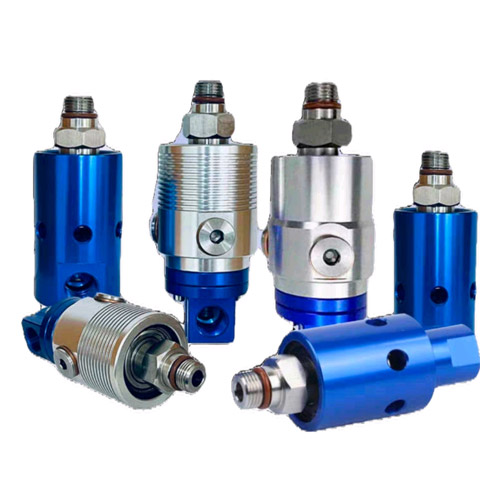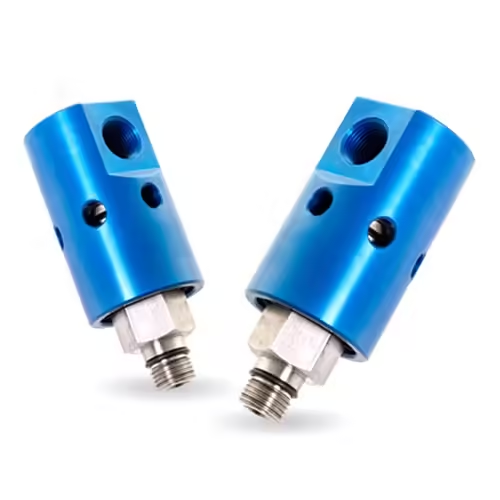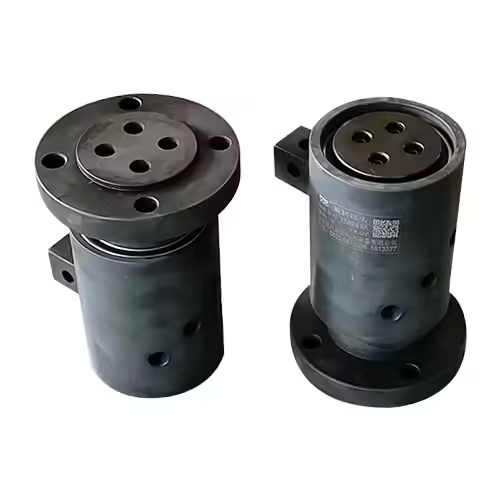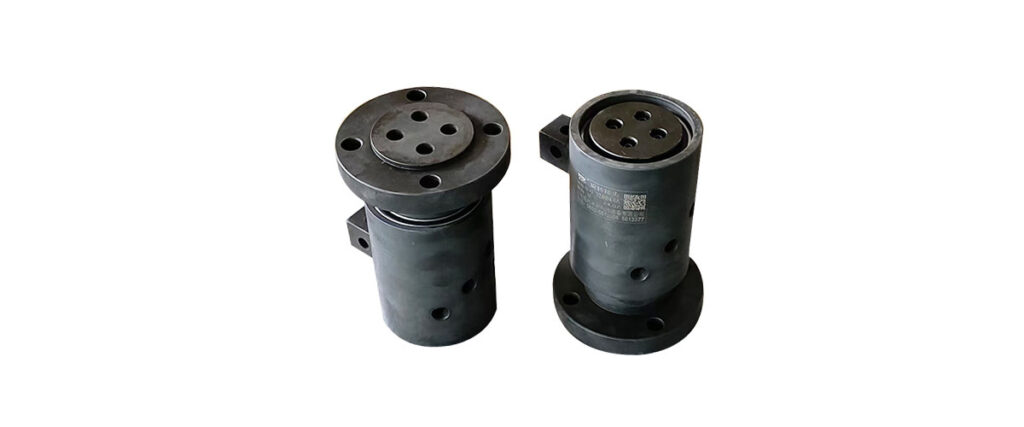Selamat Datang di blog saya!
Sebelum kita menyelami kontennya, saya ingin Anda bergabung dengan saya di platform media sosial tempat saya berbagi lebih banyak wawasan, berinteraksi dengan komunitas, dan mengunggah berita terkini. Berikut cara Anda dapat terhubung dengan saya:
Facebook:https://www.facebook.com/profile.php?id=61575858997962
Sekarang, mari kita mulai perjalanan kita bersama. Saya harap Anda menemukan konten di sini yang berwawasan, menarik, dan berharga.
Daftar isi
Perkenalan
In complex industrial machinery, rotary joints are essential for seamlessly transferring fluids, gases or signals between fixed lines and rotating parts. While standard single-pass designs are common, four-way rotary joints become indispensable when complex systems require multi-pass functionality. Choosing the right four-way rotary joint is more than just a technical decision; it has a direct impact on operational efficiency and reliability. Improper rotary joint selection can lead to costly downtime, fluid leaks, and catastrophic system failures. This blog post is designed to guide you through the complexities of four-way rotary joint design and selection, helping you understand the key features, material considerations and performance characteristics needed to make an informed choice.
To meet these technical challenges, it is critical to work with a reliable manufacturer. As a leading supplier of rotary joint solutions, Modern Sealing specializes in high quality dynamic and static sealing devices. With extensive experience and multiple patents in rotary joint technology and dynamic sealing, we know the ins and outs of designing robust and durable fluid connections. Our expertise ensures that every rotary joint we supply meets the stringent requirements of modern industrial applications, providing our customers with high quality sealing solutions.

Understanding Rotary Joint Technology
A rotary joint, often referred to as a rotating union, is a mechanical device that permits the flow of fluid (such as steam, water, thermal oil, hydraulic fluid, or air) into or out of rotating machinery. Its primary function is to maintain a leak-tight seal while allowing rotation, which is fundamental in processes like cooling rolls, drying cylinders, and filling machinery.
The basic architecture of a rotary union involves a stationary housing and a rotating shaft, with a sealing mechanism between the two. The integrity of this seal is paramount, determining the rotary union’s efficiency and lifespan. Different applications require varying levels of pressure and speed, necessitating specialized sealing technologies and bearing configurations. The design of a rotary union is highly dependent on the operational environment and the media being transferred. Understanding these fundamental principles is the first step in selecting an appropriate rotary union.
The Specifics of a 4-Way Rotary Joint
While a standard rotary union typically handles a single medium, a 4-way rotary joint is engineered for multi-channel operations. This design allows for the simultaneous transfer of up to four different media or the circulation of one medium through four independent channels.
The advantage of a 4-way rotary union lies in its multi-channel design, which significantly streamlines complex fluid systems. For instance, in automated machinery, a single 4-way rotary union might manage compressed air for tool operation, hydraulic oil for actuation, and cooling water for temperature regulation, all through the same rotational axis. This consolidation reduces the need for multiple components, simplifying the overall machine design and minimizing potential points of failure associated with complex piping.
The 4-way rotary joint must maintain absolute separation between the different media channels to prevent cross-contamination, while also handling the unique pressures and temperatures of each fluid type. The complexity of a 4-way rotary union necessitates a robust design and high-quality manufacturing to ensure reliable performance.
Critical Factors in 4-Way Rotary Joint Selection
Choosing the right 4-way rotary joint requires a detailed analysis of several key parameters. Ignoring these factors can lead to suboptimal performance and premature failure of the rotary union.
Operating Environment and Media
The type of fluid, its pressure, and the operating temperature are fundamental considerations. A rotary union designed for low-pressure air transfer will not withstand the demands of high-pressure hydraulic oil. The multi-channel design of a 4-way rotary joint means you must evaluate the compatibility of the materials with all four media types simultaneously. Temperature fluctuations and environmental factors like dust or humidity also play a role in rotary union durability.
Material Considerations
Material selection is crucial for rotary union longevity. Standard materials may suffice for general water or air applications, but aggressive media, high temperatures, or corrosive environments demand specialized materials.
For example, our 4-way rotary joint designs often feature customizable stainless steel materials, ensuring high resistance to corrosion and chemical degradation. This is particularly important for industries like chemical processing or food and beverage, where hygiene and material compatibility are non-negotiable. The choice of materials for a 4-way rotary joint significantly impacts its operational life in harsh conditions.
Seal Design and Durability
The sealing mechanism is the heart of any rotary union. For 4-way rotary union applications, the seals must not only prevent leakage but also ensure channel isolation. We utilize aerospace material wear-resistant seals, designed to withstand high operational stress and temperature extremes. These materials offer superior longevity compared to standard seals, significantly extending the service life of the rotary union. The quality of the seal in a 4-way rotary joint is the primary determinant of its efficiency.
Bearing Precision and Performance
The performance of a rotary union is heavily reliant on its bearings. Precision ball bearings are essential for smooth operation and minimal friction. High-precision bearings contribute to the smooth operation and no vibration feature of our 4-way rotary joint. Proper bearing selection ensures better lubricity and reduced maintenance requirements.
In specific designs, such as those intended for high-speed applications, we employ advanced treatments like overall QPQ carburizing. This process enhances surface hardness and wear resistance, improving the performance and reliability of the rotary union under demanding conditions.
Analyzing Key Features of High-Performance 4-Way Rotary Joints
Understanding the technical specifications and features of a 4-way rotary joint is vital for optimizing system performance. The described features of a high-quality rotary joint provide significant advantages in industrial settings.
High-precision bearings and precision ball bearings ensure a rotary union operates with exceptional smoothness, translating to no vibration during rotation. This stability is critical for applications requiring precise movement or high rotational speeds.
The use of aerospace material wear-resistant seals ensures that the seals maintain their integrity even under continuous operation and exposure to various media. Furthermore, the overall QPQ carburizing treatment mentioned earlier significantly enhances the durability of the rotary union components, providing robust protection against wear and corrosion.
The multi-channel design is optimized for versatility, suitable for a combination of air and hydraulic oil, demonstrating the 4-way rotary joint’s ability to handle diverse fluid dynamics simultaneously.
| Sambungan putar 4 arah | |
| Kecepatan maksimum | 50RPM |
| Suhu maksimum | 120℃ |
| Tekanan maksimum | Air pressure0.8MPa Oil pressure3.5MPa |
| Media yang berlaku | Compressed air, lubricating oil |
Designing for Longevity: Maintenance and Installation
A well-designed rotary union should offer not just performance but also ease of maintenance. Proper installation is the first step toward achieving the rated lifespan of a 4-way rotary joint. Misalignment during installation is a common cause of premature seal failure and bearing wear. Following manufacturer guidelines and ensuring the rotary union is correctly centered on the rotating shaft is essential.
Regular maintenance, while minimal for high-quality rotary union designs, is still important. This includes periodic inspections of seals for wear and checks for any signs of leakage. While modern rotary union designs often feature “maintenance-free” bearings, understanding the lubrication requirements for high-speed applications is necessary.
The longevity of a 4-way rotary joint is directly tied to the quality of its components. Investing in a rotary union with precision-engineered parts, such as high-precision bearings and durable seals, reduces the total cost of ownership by minimizing downtime and replacement frequency.
The Role of Sambungan Putar in Industrial Applications


The deployment of a specialized rotary union like a 4-way rotary joint is critical across various industries.
In machine tool applications, a 4-way rotary joint can deliver coolant and compressed air to the spindle simultaneously, facilitating high-speed machining and efficient chip removal. In plastics manufacturing, these joints manage the flow of cooling water to injection molds while handling hydraulic lines for mold clamping mechanisms.
The versatility of the rotary joint is evident in its ability to adapt to complex industrial needs. A robust 4-way rotary joint ensures that sophisticated machinery can operate continuously, handling multiple fluid pathways without compromising performance or safety. The reliability of the rotary union directly impacts the productivity of these operations.
Kesimpulan
Choosing the right design for a four-way rotary joint is a critical decision that can have a significant impact on the reliability and efficiency of the machine. To ensure optimal performance, focus on essential features such as high-precision bearings, durable seals made from aerospace materials, and customizable stainless steel treated with QPQ carburizing. The combination of quality components and the versatility of multi-channel designs allows rotary union to handle fluids such as air and hydraulic fluids simultaneously, reducing the complexity of industrial systems.
Modern Sealing is committed to providing high quality rotary union solutions for maximum performance and durability. Our expertise in dynamic and static sealing ensures product reliability in demanding applications. If you are looking for a high-performance rotary joint or need a customized sealing solution, contact us to discuss your specific needs and ensure your operations run smoothly.
Tanya Jawab Umum
What is the difference between a standard rotary union and a Sambungan putar 4 arah?
A standard rotary union typically has one or two passages for fluid transfer. A 4-way rotary union has four separate passages, allowing for the simultaneous transfer of multiple distinct media or the management of different fluid channels through the same axis of rotation.
How do I know if I need a 4-way rotary joint?
You likely need a 4-way rotary union if your application requires the independent routing of four different fluids (e.g., air, water, hydraulic oil, coolant) between a stationary supply and a rotating component. It is typically used in complex machinery where space is limited and multiple fluid pathways are necessary.
What media can a 4-way rotary union handle?
A 4-way rotary joint can handle a wide range of media, including air, steam, water, hydraulic oil, thermal oil, and various chemicals. The compatibility depends on the materials used in the rotary union’s construction, particularly the seals and housing.
How are leaks prevented in a 4-way rotary joint?
Leaks in a 4-way rotary union are prevented by precise sealing mechanisms, often incorporating specialized seals made from materials like aerospace composites. These seals maintain a tight barrier between the rotating and stationary parts, while also ensuring isolation between the four channels.
Are 4-way rotary joints high-maintenance?
Modern 4-way rotary union designs, especially those featuring high-precision bearings and durable seals, are engineered for low maintenance. Regular checks for fluid leaks and wear on the seals are recommended, but high-quality rotary union designs minimize the need for frequent servicing.


